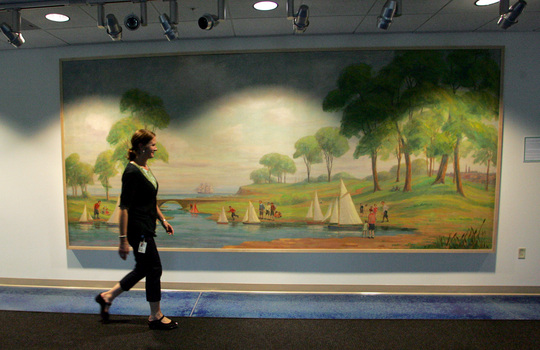
Gloucester Times

Nicole MacDonald, Cooperative Programs Specialist at NOAA, walks past a mural done by Gloucester’s Oscar Anderson in the 1930s. NOAA paid to restore the painting and it now hangs in the lobby of the new NOAA building at Blackburn Industrial Park. Mary Muckenhoupt/Gloucester Daily Times

Gloucester Times
June 17, 2010
By Steven Fletcher Staff Writer
NOAA breathes new life into historic city mural
It was once folded beneath a stage. Then, It was kept nailed to a wall, open to the elements.
But a 1930s mural by noted Gloucester artist Oscar Anderson is now once again on open public display — accompanied by photographs and fishing exhibits in the lobby at the Northeast regional offices of the National Oceanic and Atmospheric Administration.
Restoration efforts on the mural — carried out by the city of Gloucester, the Gloucester Committee for the Arts, NOAA, and Beverly’s Oliver Brothers Fine Art Restoration — concluded this week.
The city-owned mural, one of seven painted by Gloucester artists for the former Hovey Elementary School during the Works Progress Administration’s Federal Art Project launched by Franklin Delano Roosevelt in the late 1930s, had long adorned the walls of the Stage Fort Park visitors center — after the city exhumed it from beneath City Hall’s Kyrouz Auditorium.
But the Anderson painting deteriorated over its long residence nailed to the visitor center’s wall, unprotected against Gloucester’s winter.
When the city began renovating the visitor’s center, renovators asked Roger Armstrong, member of the city’s arts committee and owner of State of the Art gallery, what the committee would do with the piece.
The WPA murals belong to the city of Gloucester, so the committee chose to look into restoring the work, Armstrong said.
Anderson’s mural, described by Armstrong as a “traditional Cape-Ann style painting,” had fallen into disrepair over the years, and the arts committee contacted Oliver Brothers to get a condition report on the piece.
The restoration work was pegged at $24,000, but NOAA officials then agreed to pick up the $24,000 tab as a community project, paying for the mural’s restoration and transport.
Nicole MacDonald, NOAA’s collaborative programs director, said she had volunteered to find artwork for the federal agency’s new Blackburn Industrial Park offices when it moved in in 2008. She met with the city and the arts committee, and offered to fund the restoration and display the 7-foot by 15-foot painting in the office’s lobby.
Ultimately, Anderson’s work still belongs to Gloucester.
Though NOAA paid for the restoration and transport of the piece, the city still maintains title to it. But the NOAA office was granted permission by the city to display the piece — and will continue to as long as the organization desires.
“The process turned out to be a great collaboration between NOAA, the city of Gloucester and the committee for the arts to save local history,” said MacDonald.
Restoration work took six months under the hands of Greg Bishop and Peter Tysver, owners of Oliver Brothers.
The pair discovered the project through Tysver, a lifelong member of the Cape Ann art community and Gloucester native. His hand helped restore several works from Cape Ann artists such as Fitz Henry Lane, D. Jerome Elwell, Childe Hassam, Emile Gruppe, Gordon Grant, Oscar Anderson and others.
By the time Oliver Brothers began restoring the work, Bishop said the mural had nearly “disintegrated on the wall.”
The company stabilized the painting on a more solid stretcher — the part of a frame that holds the work taut — then heated the mural to effectively iron out folds and creases from its folded storage time at City Hall.
Replacing the backing and stretchers required manual work, since the company’s press could not accommodate a painting of that magnitude. In the creases, according to Bishop, paint had chipped away from the mural, and the company replaced the paint and placed a light glaze across the work to further hold the aging painting together.
Bishop said that restoration, in general, is a slow, thoughtful process. The Anderson mural was more difficult than most.
“This was definitely one of the more challenging projects that Oliver brothers has worked on recently,” Bishop said in a prepared statement. “The sheer size of the mural presented numerous issues that were both challenging and interesting to deal with.”
The piece stems from a culture of Cape Ann artists that thrived during 1930s Gloucester, and Anderson painted several pieces under the Federal Art Project at that time.
A Swedish immigrant from Gotland, Anderson opened a gallery on Rocky Neck, and led the Gloucester society of artists in the late 1920s and early ’30s.
According to NOAA, Anderson’s style stands as softer and “more ethereal” than many other Gloucester muralists.
You can find more examples of mural restoration HERE
Contact Oliver Brothers or call us to schedule an appointment at 617-536-2323
"*" indicates required fields